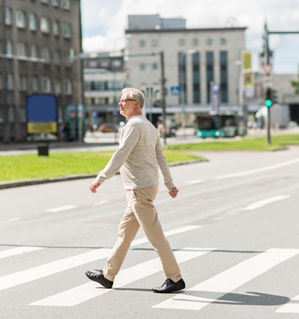 Cities pose many dangers for pedestrians, particularly for older citizens. According to a recent study reported by the American Association of Retired Persons (AARP), car accidents caused 47,025 pedestrian deaths nationwide between 2003 and 2012,and although people over age 65 years account for only 13 percent of the population, they make up 21 percent of pedestrian deaths nationwide.
Cities pose many dangers for pedestrians, particularly for older citizens. According to a recent study reported by the American Association of Retired Persons (AARP), car accidents caused 47,025 pedestrian deaths nationwide between 2003 and 2012,and although people over age 65 years account for only 13 percent of the population, they make up 21 percent of pedestrian deaths nationwide.
Why Are Older People More at Risk of Pedestrian Injuries?
By far, the biggest cause of pedestrian accidents for people of all ages is inattentive drivers. Careless driving can include activities such as disregarding stop lines, turning in front of pedestrians who have the right of way, and running red lights. Accident rates increase even further if a driver is distracted by a cellphone or is driving under the influence of drugs or alcohol. According to the Centers for Disease Control and Prevention, 48% of crashes that resulted in pedestrian deaths in 2015 involved alcohol use by the driver or the pedestrian.
In addition to all of the usual reasons for Tennessee pedestrian accidents, senior citizens face specific difficulties that place them more at risk of being struck by cars, including:
- Roadway design. Cities are not always designed for the benefit of people traveling on foot. While streets and thoroughfares account for the needs of drivers and cars, pedestrian safety is often treated as an afterthought. Roadway designers and local municipalities may be held liable if the pedestrian crossing was obstructed, if the conditions did not have safety measures such as islands and raised medians, or if there was not sufficient lighting to allow drivers to see the pedestrian for the full crossing.
- Short signals. People undergo many changes in their bodies as they age, and one of these is an inability to move as quickly as they did in their youth. Not only does it take longer for many senior citizens to cross the street, lost mobility makes them less likely to dodge an oncoming car or get out of the way of a speeding bicyclist at the last minute. Older people are also more likely to suffer vision problems and have difficulty hearing, placing them at risk of entering traffic when it is not safe.
- Jaywalking. Although pedestrians are supposed to cross at designated crosswalks, many cross mid-block or at an angle. Some elderly people even choose to jaywalk in order to avoid busy or dangerous intersections, or to give cars more time to see them. Elderly people may be seen to be at fault for jaywalking, even if their crossing point was a conscious choice to help avoid an accident.
- Urban roads. The majority of pedestrian fatalities occur in urban areas and involve vehicles traveling between 35 and 40 mph. Longer and wider highways and faster-moving traffic make it nearly impossible for older people to cross the road before the lights begin to change,and the cars on these roads are likely to be going so quickly that they cannot stop in time to avoid a crash.
- Crash injuries. While many pedestrians who are hit by cars traveling under 20 mph will survive the accident, even the effects of a non-fatal crash can prove life-threatening for senior victims. An elderly person who suffers fractured ribs may need intensive care or spend days attached to a ventilator, and seniors may never fully recover from a broken hip or head injury.
Who Is Responsible for a Pedestrian Crash With a Senior Citizen in Tennessee?
In many cases, both a driver and a pedestrian will share some portion of fault for an accident. Under Tennessee’s modified comparative negligence laws, a victim may be determined to be up to 50 percent liable for a crash and still receive damages from the other party. However, the amount a victim can receive will be reduced by the percentage of liability for the accident. For example, if you are awarded $100,000 but are 30 percent at fault, you will only receive $70,000 in damages.
If you have been injured in a pedestrian accident, we can help you get the payment you deserve for your injuries, lost income, property damage, and pain and suffering. Fill out the quick contact form on this page to have the attorneys at GriffithLaw explain your rights in your free case evaluation, or order a free copy of our book, The 10 Worst Mistakes You Can Make With Your Tennessee Injury Case.
|
Related Links: |

